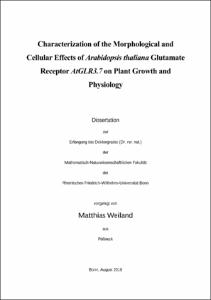Weiland, Matthias: Characterization of the Morphological and Cellular Effects of Arabidopsis thaliana Glutamate Receptor AtGLR3.7 on Plant Growth and Physiology. - Bonn, 2019. - Dissertation, Rheinische Friedrich-Wilhelms-Universität Bonn.
Online-Ausgabe in bonndoc: https://nbn-resolving.org/urn:nbn:de:hbz:5n-53031
Online-Ausgabe in bonndoc: https://nbn-resolving.org/urn:nbn:de:hbz:5n-53031
@phdthesis{handle:20.500.11811/7832,
urn: https://nbn-resolving.org/urn:nbn:de:hbz:5n-53031,
author = {{Matthias Weiland}},
title = {Characterization of the Morphological and Cellular Effects of Arabidopsis thaliana Glutamate Receptor AtGLR3.7 on Plant Growth and Physiology},
school = {Rheinische Friedrich-Wilhelms-Universität Bonn},
year = 2019,
month = jan,
note = {There is a ubiquitous involvement of glutamate receptor-like receptors in all major physiological processes in plants and these proteins have similar operating properties as animal ionotropic glutamate receptors. The aim of this work was to embed the glutamate receptor AtGLR3.7 within the plant physiology of Arabidopsis thaliana. To that end, AtGLR3.7 overexpression plant lines were constructed, and their phenotypes compared to an AtGLR3.7 knockout line and wildtype Arabidopsis plants (Col-0).
The overexpression of AtGLR3.7 provoked a marked increase in plant growth of aerial and underground tissues. An explanation for the observed growth accelerations in the AtGLR3.7 overexpression lines was found in an increased meristem size and an enhanced meristematic activity of the RAM while the knockout of AtGLR3.7 caused a reduction in meristem activity and spatial expansion. Furthermore, it was found that L-glutamate, as an agonist of GLRs, strongly reduced root growth in the AtGLR3.7 overexpression lines while the AtGLR3.7 knockout line experienced a root growth acceleration.
Gene expression data for selected key regulators of the plant's cell cycle revealed a tendency for all transgenic plant lines to upregulate S-phase genes as well as adjust M-phase regulator gene expressions which was reflected by enhanced gene transcript levels of elements of the E2F-DP pathway as well as various other cyclins and cyclin-dependent kinases. An explanation for similar upregulations in atglr3.7 was found by measuring the transgenic plant lines' nuclear DNA content. Cells of AtGLR3.7 knockout and overexpression lines exhibited an increase in their endopolyploidy levels represented by an elevation of nuclear DNA contents. It is notable that, these augmentations were much more pronounced in atglr3.7.
The plant's biotic and abiotic stress tolerances were also affected by an overexpression or knockout of AtGLR3.7. The uptake of Na+ from the medium was significantly increased in AtGLR3.7 overexpressing lines whereas the Na+ content in atglr3.7 was markedly reduced. In connection to that, the modified Na+ uptake capacities of the transgenic plant lines were presumably responsible for the measured elevated salt tolerance of atglr3.7 against mild and moderate salt stress. The observed enhanced resistance of the transgenic plant lines against Pseudomonas syringae likely had its origin in the increased endopolyploidy levels. Hence, increased levels of nuclear DNA within the all transgenic AtGLR3.7 plant lines could create a multiplication of potential DNA targets for various pathogen effectors and the augmented chromatin quantities could also lead to an enhanced proteinogenesis, raising the possibility of triggering R gene/protein-mediated effector-triggered immunity within the affected plant cells.},
url = {https://hdl.handle.net/20.500.11811/7832}
}
urn: https://nbn-resolving.org/urn:nbn:de:hbz:5n-53031,
author = {{Matthias Weiland}},
title = {Characterization of the Morphological and Cellular Effects of Arabidopsis thaliana Glutamate Receptor AtGLR3.7 on Plant Growth and Physiology},
school = {Rheinische Friedrich-Wilhelms-Universität Bonn},
year = 2019,
month = jan,
note = {There is a ubiquitous involvement of glutamate receptor-like receptors in all major physiological processes in plants and these proteins have similar operating properties as animal ionotropic glutamate receptors. The aim of this work was to embed the glutamate receptor AtGLR3.7 within the plant physiology of Arabidopsis thaliana. To that end, AtGLR3.7 overexpression plant lines were constructed, and their phenotypes compared to an AtGLR3.7 knockout line and wildtype Arabidopsis plants (Col-0).
The overexpression of AtGLR3.7 provoked a marked increase in plant growth of aerial and underground tissues. An explanation for the observed growth accelerations in the AtGLR3.7 overexpression lines was found in an increased meristem size and an enhanced meristematic activity of the RAM while the knockout of AtGLR3.7 caused a reduction in meristem activity and spatial expansion. Furthermore, it was found that L-glutamate, as an agonist of GLRs, strongly reduced root growth in the AtGLR3.7 overexpression lines while the AtGLR3.7 knockout line experienced a root growth acceleration.
Gene expression data for selected key regulators of the plant's cell cycle revealed a tendency for all transgenic plant lines to upregulate S-phase genes as well as adjust M-phase regulator gene expressions which was reflected by enhanced gene transcript levels of elements of the E2F-DP pathway as well as various other cyclins and cyclin-dependent kinases. An explanation for similar upregulations in atglr3.7 was found by measuring the transgenic plant lines' nuclear DNA content. Cells of AtGLR3.7 knockout and overexpression lines exhibited an increase in their endopolyploidy levels represented by an elevation of nuclear DNA contents. It is notable that, these augmentations were much more pronounced in atglr3.7.
The plant's biotic and abiotic stress tolerances were also affected by an overexpression or knockout of AtGLR3.7. The uptake of Na+ from the medium was significantly increased in AtGLR3.7 overexpressing lines whereas the Na+ content in atglr3.7 was markedly reduced. In connection to that, the modified Na+ uptake capacities of the transgenic plant lines were presumably responsible for the measured elevated salt tolerance of atglr3.7 against mild and moderate salt stress. The observed enhanced resistance of the transgenic plant lines against Pseudomonas syringae likely had its origin in the increased endopolyploidy levels. Hence, increased levels of nuclear DNA within the all transgenic AtGLR3.7 plant lines could create a multiplication of potential DNA targets for various pathogen effectors and the augmented chromatin quantities could also lead to an enhanced proteinogenesis, raising the possibility of triggering R gene/protein-mediated effector-triggered immunity within the affected plant cells.},
url = {https://hdl.handle.net/20.500.11811/7832}
}






